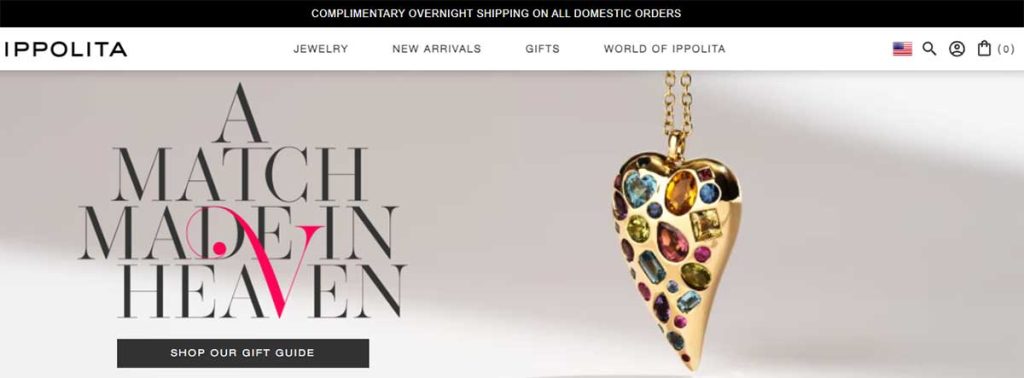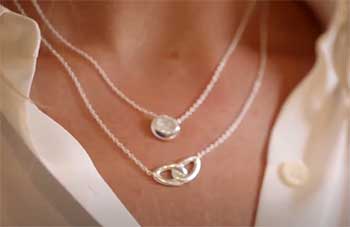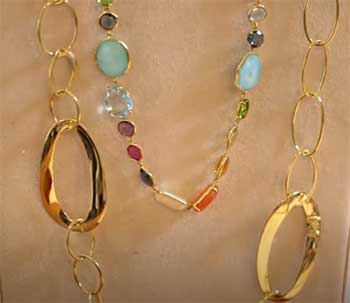For jewelry aficionados, the Ippolita name signifies the epitome of luxurious, high-end designs. From dainty layered necklaces to bold cuffs and statement earrings, Ippolita pieces often carry price tags in the thousands or even tens of thousands.
But what exactly makes this jewelry so valuable?
Ippolita’s astronomical prices stem from a myriad of factors. From the quality of materials to the brand’s marketing and exclusivity, many elements work together to drive the worth of these designs sky-high.
Ippolita has carved out a niche as an aspirational name in fine jewelry. Ownership signifies entry into an elite circle of fashionistas and influences.
Let’s explore the key reasons why Ippolita jewelry comes with such astounding price tags and continues to drive desire among luxury shoppers.
Reasons For Ippolita Jewelry Being So Expensive
Here are all those reasons you need to know:
- The Ippolita Brand Commands Respect
- Celebrity Power Sells the Sizzle
- The Perception of Investment and Resale Value
- Scarcity Marketing Drives Up Perceived Value
- Innovative Designs Fill a Niche
- Strategic Pricing Anchoring
- Positioning as Status Symbols
- Costly Materials Don’t Come Cheap
- Handcrafting and Limited Production
- Diamond and Gemstone Markups
- Aggressive Retail Markups
- Customer Service and Presentation Costs
- Geographic Variations in Pricing
- Brand Desire Allows Higher Pricing Ceilings
Let’s talk about those reasons in detail.
- The Ippolita Brand Commands Respect

Over the past two decades, Ippolita has built an esteemed reputation and name recognition in the jewelry world. Under the creative vision of namesake founder Ippolita Rostagno, the brand has come to be revered for its high-quality, handcrafted designs that fuse classic and contemporary styling.
The Ippolita brand carries an air of prestige and luxury that enables it to command premium prices. Shoppers trust that pieces from the iconic jewelry house will not just be beautiful, but exclusionary and thoughtfully made.
They pay for the confidence that they are purchasing from a respected luxury brand.
This branding power gives Ippolita significant pricing control. The brand does not need to compete as much on affordability. Its devoted customer base is willing to pay higher prices to own a name-brand piece.
- Celebrity Power Sells the Sizzle
Like other status brands, Ippolita gets a major boost from celebrity endorsements. Spotting A-list stars like Jennifer Lopez, Julianne Moore, and Taylor Swift wearing Ippolita designs gives the jewelry line major star power.
Consumers aspire to emulate the lavish lifestyles of their favorite celebrities. When Hollywood It-girls consistently don Ippolita rings, necklaces, and earrings for red carpet events, it ramps up interest and demand.
By gifting jewelry to influencers and stars, Ippolita benefits from the exposure. Fans take it as a sign of the quality and prestige of the brand if top celebrities wear it. The buzz substantiates the high pricing. If prices were truly exorbitant, celebrities couldn’t justify splurging either, right?
This celebrity halo effect enables Ippolita to continously elevate its pricing tiers. As stars help sell the sizzle and aspirational appeal of the designs, prices remain unsupported by materials value.
- The Perception of Investment and Resale Value
One significant factor in Ippolita’s pricing is the perception that the jewelry represents a valuable investment. There is a commonly held belief that spending more on gold, diamonds, and fine jewelry is worthwhile because they will retain value.
This notion persists even though the reality is most jewelry, even at luxury price points, decreases in value after purchase. Brand new jewelry sold at retail sees markups of 2-3X over the base material and production costs.
Once purchased, precious metals and diamonds do have some resale value based on daily market commodity rates. However, pieces typically only fetch 10-20% of retail pricing when resold. Despite this, consumers still buy into the idea of jewelry as an investment.
Ippolita benefits from this consumer mindset. Shoppers are willing to spend freely under the guise it is a smart money move. This gives the brand more leeway to inflate prices.
- Scarcity Marketing Drives Up Perceived Value

From limited edition runs to one-of-a-kind designs, Ippolita leverages scarcity marketing to make its jewelry seem extra valuable. The brand often promotes new collections as only available for a short time. Selections may sell out fast and not be replenished once stock runs out.
This technique positions Ippolita jewelry as more special and coveted. When shoppers encounter a necklace or ring they love, they feel pressured to buy it quickly before it disappears.
The perception of exclusivity allows Ippolita to justify higher pricing. Shoppers are willing to pay top dollar if they believe an item is truly scarce or hard to come by. They feel like they are securing a rare prize.
Scarcity marketing will likely always play a role in driving demand higher for Ippolita. As long as the brand can convince shoppers they must act fast, price becomes a secondary concern.
Also Read: This Is Why Ross-Simons Jewelry Is So Cheap.
- Innovative Designs Fill a Niche
Ippolita prices its collections high not just for the materials, but also the conceptual value. Under Creative Director Ippolita Rostagno, the brand prides itself on constant innovation and boundary-pushing design.
Rather than rehash the same old jewelry styles, Ippolita taps into runway trends, artisanal techniques, and a modern sensibility. Every season brings something new – whether it is a lustrous shape, an edgy mixed metal combo, or a fresh styling.
This constant innovation requires immense investment into design, materials research, and production capabilities. But it also allows Ippolita jewelry to fill a niche market. Shoppers know they cannot find such unique pieces from other brands.
The exclusivity of Ippolita’s latest designs enables the prices to remain high. Customers are willing to pay more to own a trendsetting piece before anyone else.
- Strategic Pricing Anchoring
Anchoring is a psychological concept where initial information provided sets the tone for perception. Luxury brands like Ippolita leverage this strategically with pricing tiers.
Ippolita prices entry level items such as thin stacking rings and subtle necklaces in the few hundred dollar range. This frames the brand as affordable luxury. Shoppers see approachable price points at the bottom, even if they don’t intend to purchase there.
As customers browse up the pricing scale, seeing items priced in the tens of thousands does not feel disproportionate. The anchoring effect makes the high-ticket prices seem reasonable in context.
Anchoring allows Ippolita to scale pricing brackets unattainably high. Sticker shock does not set in as long as lower baselines exist.
- Positioning as Status Symbols

Ippolita designs pieces meant to signify status.
The brand wants shoppers to feel they are joining an elite circle by owning its jewelry.
Models and marketing materials depict lavish lifestyles and conveys entrance into the upper echelons of class and style.
Unlike mass market mall brands, Ippolita positions itself as exclusively for those of means. This aspirational appeal allows it to demand higher prices.
Those who buy Ippolita wish to communicate taste, luxury, and the means to afford such expenses. By pricing high, the brand attracts shoppers who equate cost with prestige and superiority.
They pay for jewelry to broadcast social status through financial flexing. Ippolita happily indulges this desire with eye-popping price tags.
Also Read: This Is Why Le Vian Jewelry Is So Expensive.
- Costly Materials Don’t Come Cheap
Of course, one of the most fundamental factors in Ippolita’s pricing is the intrinsic cost of materials. As a fine jewelry brand, Ippolita uses solid gold, sterling silver, platinum and diamonds for most pieces. These materials carry significant inherent value.
Solid gold especially carries hefty pricing minimums. As a precious metal commodity, gold fluctuates daily but averages around $1,800 per ounce. Ippolita uses 18K gold containing 75% pure gold in its designs.
Other metals like platinum and silver also drive baseline costs up. Then precious stones like diamonds, emeralds, and sapphires get factored in based on carat weights and grades.
Even Ippolita’s most minimal, sleek designs require expensive materials outlay. So materials cost sets pricing expectations firmly in the luxury bracket before considering other factors.
- Handcrafting and Limited Production
Luxury brands emphasize artisanal craftsmanship to justify pricing. Ippolita is no exception. The brand notes each piece is thoughtfully designed and handmade in limited quantities.
Jewelry artisans specially train to master Ippolita’s techniques. Whether working in precious metals or setting gemstones, their specialized skills demand premium compensation.
Between craftsmanship and limited production runs, Ippolita cannot leverage economies of scale to lower pricing. These human-driven processes mean costs per piece remain high. But it allows the brand to emphasize quality over mass manufacturing.
The handcrafted, low volume nature of production enables Ippolita to attach luxury pricing. Shoppers connect specialized artisans and limited availability with more value.
- Diamond and Gemstone Markups

As a fine jeweler, Ippolita markings up diamonds and colored gemstones significantly for retail pricing.
These precious stones already command high base prices for carat weight based on grade.
But jewelry brands further mark up diamonds and gems well above wholesale prices when setting them into designs.
It is standard practice to sell them at 2-3X cost.
This means Ippolita can take a diamond that wholesale for $1,000 and set a retail price around $3,000 – $5,000. Such enormous markups enablefine jewelers to inflate prices while still highlighting the genuine diamond and gem values at play.
Other than metals like gold and platinum, diamonds and colored gemstones deliver exceptional profit margins. So Ippolita maximizes these expensive stones in designs. More diamonds/gems mean higher retail markups and end pricing.
- Aggressive Retail Markups
Ippolita jewelry goes through two rounds of markup before reaching the final retail tag. First, Ippolita itself marks up designs after calculating materials, labor, and other costs.
Already pricey pieces then go to retail partners who add their own markup. Major high-end retailers like Neiman Marcus can double or triple wholesale pricing.
By the time shoppers encounter Ippolita jewelry at luxury retailers, pieces reflect extreme cumulative markups. But retailers need healthy margins, so Ippolita cannot bypass them to get better direct-to-consumer pricing.
These baked-in markups contribute to the astronomical end pricing. Ippolita aims for prestige positioning rather than affordability, so huge markups align with brand image.
But understanding the retail math helps explain how raw material costs snowball into such staggering retail amounts.
Also Read: This Is Why John Hardy Jewelry Is So Expensive.
- Customer Service and Presentation Costs
Luxury brands also pour resources into enhancing the customer experience from browsing to purchase. Everything from luxe packaging to personal associate assistance adds overhead – and drives up pricing.
Ippolita invests significantly in areas like branding, store design, and service. Potential customers should feel pampered and delighted from start to finish. Staff must be trained to provide excellent support matching brand prestige.
While customers may not think about it, these elevated service and experiential costs allow Ippolita to justify higher pricing. The costs get built in. Shoppers pay for more than just materials; they pay for the associated luxury treatment.
- Geographic Variations in Pricing
Ippolita prices fluctuate across geographies based on factors like import duties, supply chain costs, and general affordability. This leads to pricing discrepancies globally.
For example, Ippolita pieces face heavy import taxes when entering certain countries. These taxes and tariffs get incorporated into retail markup abroad. The brand may also engraft country-specific profit margins.
As an illustration, a ring selling for $5,000 USD might be priced at 6500 EUR in France. Geographic discrepancies enable localization but bloat costs.
- Brand Desire Allows Higher Pricing Ceilings
Ultimately, Ippolita can charge sky-high prices because brand enthusiasts remain willing to pay. The brand has built up strong recognition and prestige over 20+ years. It represents the pinnacle of aspirational jewelry for devotees.
As an established luxury player, Ippolita retail prices far exceed the true costs of production. But the brand has fostered desire so passionate among shoppers that normal pricing ceilings dissolve.
Those seeking the finest precious metal designs accept Ippolita’s pricing as reflective of the brand’s stature and reputation. The name alone communicates intrinsic worth.
So unlike accessible fashion brands, Ippolita has room to push prices higher until diminishing returns impact demand. Its cult-like following keeps pricing power strong.
Also Read: This Is Why Heidi Daus Jewelry Is So Expensive.
Frequently Asked Questions (FAQ)
No, Ippolita jewelry is not made in China. The brand produces its jewelry in Italy and the United States. Its headquarters and design studio are based in New York City.
Yes, some Ippolita jewelry production does take place in Italy. The brand has a factory in Vicenza, Italy that creates some of its gold and sterling silver pieces. However, not all Ippolita jewelry comes from Italy – the brand also produces jewelry at its New York headquarters.
Ippolita was founded by Ippolita Rostagno in 1999 in New York City. Rostagno launched the brand after moving to the U.S. from Italy, where she studied ancient jewelry crafting techniques. Ippolita initially gained attention for its handcrafted gold and gemstone pieces. It has grown into one of the most recognizable high-end jewelry brands, carried by over 300 retailers globally.
Ippolita remains privately owned by founder Ippolita Rostagno. She continues to lead the brand’s creative vision as Director of Design. Rostagno co-owns Ippolita with CEO Steve Larkin, who joined in 2016 to accelerate the brand’s growth. Larkin’s background is in luxury retail, having previously worked with Richemont brands.
Wrapping Up
In summary, Ippolita jewelry commands astronomically high prices for a range of reasons. From the precious materials and handcrafted quality to brilliant branding and celebrity endorsements, Ippolita has made its name synonymous with aspirational luxury.
For devotees of the brand, owning an Ippolita piece represents joining an elite tier of fashionistas. This prestige, along with perceived value, innovative designs, and strategic pricing, enables Ippolita to continue charging thousands of dollars for its jewelry.




